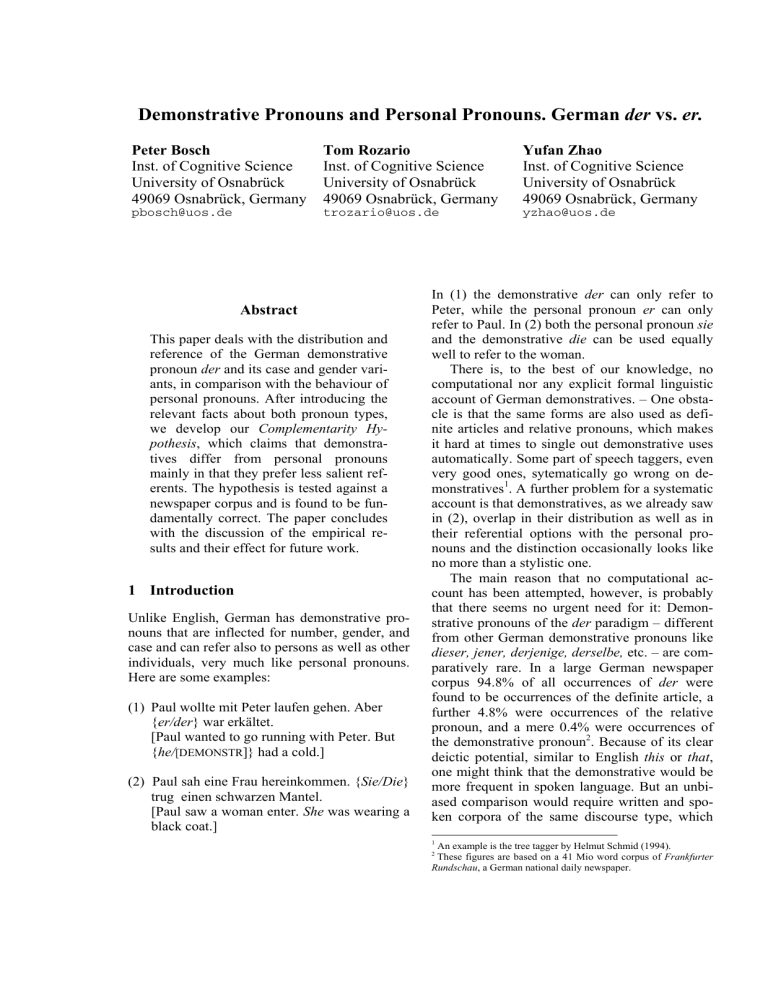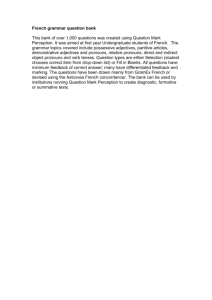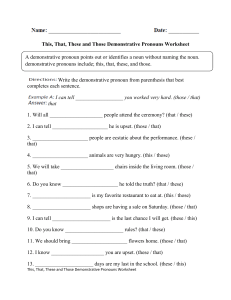
Demonstrative Pronouns and Personal Pronouns. German der vs. er.
Peter Bosch
Inst. of Cognitive Science
University of Osnabrück
49069 Osnabrück, Germany
Tom Rozario
Inst. of Cognitive Science
University of Osnabrück
49069 Osnabrück, Germany
Yufan Zhao
Inst. of Cognitive Science
University of Osnabrück
49069 Osnabrück, Germany
pbosch@uos.de
trozario@uos.de
yzhao@uos.de
Abstract
This paper deals with the distribution and
reference of the German demonstrative
pronoun der and its case and gender variants, in comparison with the behaviour of
personal pronouns. After introducing the
relevant facts about both pronoun types,
we develop our Complementarity Hypothesis, which claims that demonstratives differ from personal pronouns
mainly in that they prefer less salient referents. The hypothesis is tested against a
newspaper corpus and is found to be fundamentally correct. The paper concludes
with the discussion of the empirical results and their effect for future work.
1 Introduction
Unlike English, German has demonstrative pronouns that are inflected for number, gender, and
case and can refer also to persons as well as other
individuals, very much like personal pronouns.
Here are some examples:
(1) Paul wollte mit Peter laufen gehen. Aber
{er/der} war erkältet.
[Paul wanted to go running with Peter. But
{he/[DEMONSTR]} had a cold.]
(2) Paul sah eine Frau hereinkommen. {Sie/Die}
trug einen schwarzen Mantel.
[Paul saw a woman enter. She was wearing a
black coat.]
In (1) the demonstrative der can only refer to
Peter, while the personal pronoun er can only
refer to Paul. In (2) both the personal pronoun sie
and the demonstrative die can be used equally
well to refer to the woman.
There is, to the best of our knowledge, no
computational nor any explicit formal linguistic
account of German demonstratives. – One obstacle is that the same forms are also used as definite articles and relative pronouns, which makes
it hard at times to single out demonstrative uses
automatically. Some part of speech taggers, even
very good ones, sytematically go wrong on demonstratives1. A further problem for a systematic
account is that demonstratives, as we already saw
in (2), overlap in their distribution as well as in
their referential options with the personal pronouns and the distinction occasionally looks like
no more than a stylistic one.
The main reason that no computational account has been attempted, however, is probably
that there seems no urgent need for it: Demonstrative pronouns of the der paradigm – different
from other German demonstrative pronouns like
dieser, jener, derjenige, derselbe, etc. – are comparatively rare. In a large German newspaper
corpus 94.8% of all occurrences of der were
found to be occurrences of the definite article, a
further 4.8% were occurrences of the relative
pronoun, and a mere 0.4% were occurrences of
the demonstrative pronoun2. Because of its clear
deictic potential, similar to English this or that,
one might think that the demonstrative would be
more frequent in spoken language. But an unbiased comparison would require written and spoken corpora of the same discourse type, which
1
An example is the tree tagger by Helmut Schmid (1994).
These figures are based on a 41 Mio word corpus of Frankfurter
Rundschau, a German national daily newspaper.
2
we have not been able to acquire. So we have to
leave this point to speculation3.
So, why would one want a computational
identification of demonstratives, and why would
one want a better understanding of their reference? On the one hand, there is of course the motivation from applications, similar as for all other
work on reference resolution: A treatment of
demonstratives is clearly needed, e.g., for machine translation. Nearly no German demonstrative can be adequately translated into English, or
most other languages, without reference resolution.
On the other hand, independent of applications, we believe that an improved understanding
of demonstratives may contribute both to a better
understanding of processes of pronominal reference and to theoretical accounts of information
structure and the dynamics of discourse.
The interesting point about German demonstratives in this connection is that they allow for
a fairly direct comparison of pronominal anaphoric and demonstrative reference in a way this
comparison is not possible for other languages.
In English we could look at differences between
it, this, and that. But here the range of potential
referents brings in a number of additional complications (cf. Passonneau 1989, Webber 1991,
Eckert & Strube 2000) that are avoided when we
compare personal and demonstrative pronouns in
German.
This paper takes a few modest steps towards
an account of the distribution and reference of
demonstratives, but what we have to offer is still
work in progress. We have not yet looked at all
forms of the demonstrative. What we have
worked out so far is an hypothesis about the distinction between different uses of the demonstrative and personal pronouns, and we have put this
hypothesis to the test with a small 350,000 word
corpus of written German.
3
The Verbmobil corpus of spoken German (http:// verbmobil.dfki.de/) has a ratio of personal pronouns to demonstratives of
1:4, while the Negra corpus of written German yields about 8:1.
However, this comparison remains inconclusive: the Verbmobil
corpus consists of dialogues negotiating the time and place of appointments, while the Negra corpus is a regular daily newspaper
corpus with obviously vastly different discourse structure.
2 Demonstrative and personal pronouns
At a first glance there is considerable overlap in
the distribution of demonstrative and personal
pronouns. In many contexts, as already in example (2), either form seems acceptable and semantic, pragmatic, or even stylistic differences are
hard to pinpoint. This is also true in the following cases:
(3) Am Dienstag, 16. Juni, können dann Falkensteiner ihren Sondermüll von 9 bis 10 Uhr zu
dem Wagen bringen. {Er/Der} parkt auf
dem Parkplatz beim Bürgerhaus.
[On Tuesday, 16 June, the Falkensteiners can
take their hazardous waste to the van between 9 and 10 a.m. It is parked in the parking lot at the Civic Centre.]
(4) Zunächst waren die Mietforderungen des
Investors (38 Mark pro Quadratmeter) zu
hoch. {Er/Der} reduzierte sie dann auf unter
30 Mark.
[At first the rent demands of the investor (38
marks per square meter) were too high. Then
he reduced them to under 30 Marks.]
The impression that there is an area of overlap
where the function of the demonstrative pronoun
is indistinguishable from the anaphoric personal
pronoun and where the two forms could be substituted for each other without a clear grammatical or semantic difference was confirmed in two
psycholinguistic experiments carried out by our
project group (see Cummins et al. (in preparation)). Self-paced reading as well as native
speakers' acceptability preferences yielded no
significant difference.
This functional overlap of personal and demonstrative pronouns may well be an artefact of
underspecified data though. If, as we shall argue,
the difference between the two types of pronouns
is a matter of information structure, then the distinction may not show up when not enough information structure is visible – most clearly
when we consider odd sentences in isolation, but
often also in sentence pairs.
Still, there are occurrences of the two pronoun types for which the difference is quite clear
as already in (1), repeated here:
(1) Paul wollte mit Peter laufen gehen. Aber
{er/der} war erkältet.
[Paul wanted to go running with Peter. But
{he/[DEMONSTR]} had a cold.]
The er can only be interpreted with reference to
Paul, while der must refer to Peter – a difference
that is hard to emulate in an English translation.
But also a difference in grammaticality can be
found. In (5) only the demonstrative is allowed
while the personal pronoun would be ungrammatical:
(5) Die Gelder sollen nicht aus dem Etat des
Umweltministeriums, sondern aus {dem/
*ihm}
des
Entwicklungsministeriums
fließen.
[The money should not come out of the
budget of the Ministry of Environment, but
from [the budget] of the Ministry of Development.]
The way that demonstratives differ from personal
pronouns may in some respects be reminiscent of
differences found in English between stressed
and unstressed personal pronouns, as documented by Akmajian and Jackendoff (1970). Cf.4
(6) When {he/HE} came home, John was tired.
where the unstressed anaphoric pronoun clearly
refers to John and the stressed HE cannot be so
interpreted. In addition we have cases like those
brought up by Lakoff (1971):
(7) John called Fred a Republican. Then he inSULted him.
(7') John called Fred a Republican. Then HE insulted HIM.
Also here the referential options of the pronouns
change when the pronouns are accentuated. Observations like these suggest something like a
complementarity between stressed and unstressed personal pronouns in English as was
claimed in Kameyama's (1999) Complementary
Preference Hypothesis: "A focused pronoun [i.e.
stressed personal pronoun] takes the complemen4
Stressed syllables are marked typographically by capitals.
tary preference of the unstressed counterpart." –
where the referents of both stressed and unstressed pronouns come from the current focus of
attention of the discourse, the Forward-looking
Centre of the preceding utterance, in terms of
Centering Theory (Grosz e.a. 1995).
But the distinction between German personal
and demonstrative pronouns is not the same. The
demonstrative in (1) does not translate into English as a stressed personal pronoun: While der in
(1) can only refer to Peter, HE in (1') is just
oddly ambiguous:
(1') Paul wanted to go running with Peter. But
HE had a cold.
Kameyama (1999) is probably right characterising the function of English stressed personal
pronouns in terms of an Alternative Semantics
approach to focus (Rooth 1992), and hence in
terms of contrast, and an analysis of stressed
German and English personal pronouns in terms
of contrast and markedness was also put forward
in Bosch (1988). The difference between personal pronouns and demonstratives in German,
however, cannot be captured along these lines:
Even though complementarity plays a role, the
category of contrast is here absent.
The basic regularity that we find in the behaviour of demonstratives is that they
i. choose from several antecedents (that obey
the relevant number and gender constraints
as well as subcategorisation constraints of
the relevant predicate) the one whose referent
is preferentially not at the top salience rank
(not a topic); Cf. (1), (3), (4).
ii. pick up a unique antecedent (that obeys the
relevant number and gender constraints as
well as subcategorisation constraints of the
relevant predicate), even though it stands for
the most salient referent (the topic). They
may also accommodate a generic referent
that obeys the subcategorisation constraints
of the relevant predicate (cf. (8) below). In
this condition their referential options are
identical to those of referential anaphoric
personal pronouns, except for a certain stylistic markedness; cf. (2).
iii. when accompanied by a pointing gesture
they refer to a unique referent that was not
salient before.
Condition (iii), even though without direct relevance for written language, probably provides
the clearest intuitive understanding for the function of demonstratives: They highlight a previously non-salient referent, and in a sense they
presuppose the non-salience of their referents. –
If their reference defaults to salient discourse
entities, as under condition (ii), when no other
suitable discourse referents are available, we observe an effect of stylistic markedness: The referent is represented, as it were, as something put
at a distance. A similar effect is seen in English
when, e.g., a salient female person is referred to
as "that woman" or the current head of government as "that prime minister".
For the purposes of this paper we summarize
this hypothesis about the function of demonstratives in the following form:
Complementarity Hypothesis
Anaphoric personal pronouns prefer referents
that are established as discourse topics, while
demonstratives prefer non-topical referents.
Clearly, this is a working hypothesis that needs
further elaboration, in particular with regard to
the notions of salience and topic. But it is sufficient for a first validation with respect to corpus
data, provided we can make it operational.
In line with most research in the area, guided
in particular by the Keenan and Comrie's (1977)
Accessibility Hierarchy, Givòn's (1984:139)
Topicality Hierarchy, and Centering Theory
(Grosz e.a. 1995), we decided that noun phrases
that occur in the nominative are thereby ceteris
paribus very likely to establish their referent as a
topic for the following sentence, and that noun
phrases that are not in the nominative are less
likely to establish topics for the following sentence. We disregard in this study all other parameters that may influence salience or topichood, such as definiteness, referent type, voice,
or embeddedness.
Before we can check our hypothesis on corpus
data, however, we have to deal with a number of
smaller problems related to the identification of
demonstratives.
3 Identifying demonstrative uses of der
The first problem is the identification of those
occurrences of the relevant forms that are actually used as demonstratives. The forms of the
demonstrative der in German are largely identical with those of the relative pronoun and the
definite article. So, how do we identify
demonstrative uses?
3.1 Demonstratives and definite articles
Demonstrative uses of der and its morphological
variants are formally identical with definite article uses – except for the genitive and the dative
plural forms (cf. tables 1 and 2). Their gender
and number is determined either by the semantic
classification (animacy, sex) of the intended referent or by the gender and number of a (virtual or
actual) antecedent (cf. Bosch 1987:72-73).
Definite determiner occurrences always start
an NP, i.e. they are followed by an (attributive)
adjective, adverb, numeral, or noun, etc., while
demonstrative pronouns are themselves of the
category NP. Some unclarity may arise though in
cases that could look like cases of elided nouns,
as in (5) above, repeated here.
nom
gen
sing
masc
der
dessen
fem
die
deren
neut
das
dessen
dat
acc
dem
den
der
die
dem
das
plur
m/f/n
die
deren/
derer5
denen
die
Table 1: Forms of the demonstrative pronoun
nom
gen
dat
acc
sing
masc
der
des
dem
den
fem
die
der
der
die
neut
das
des
dem
das
plur
m/f/n
die
der
den
die
Table 2: Forms of the definite article
5
derer only when immediately followed by a relative clause, or as
a relative pronoun when preceded by a preposition. But cf.
Bærentzen (1995) for details.
(5) Die Gelder sollen nicht aus dem Etat des
Umweltministeriums, sondern aus dem des
Entwicklungsministeriums fließen.
[The money should not come out of the
budget of the Ministry of Environment, but
from [the budget] of the Ministry of Development.]
One might want to argue that dem is really elliptical for dem Etat; and indeed the insertion of
Etat would lead to a fully acceptable paraphrase.
Still, dem can here only be analysed as a demonstrative pronoun. The evidence comes from a
plural variant:
(5') Die Gelder sollen nicht aus den Mitteln des
Umweltministeriums, sondern aus {denen/
*den} des Entwicklungsministeriums fließen.
[The money should not come out of the
means of the Ministry of Environment, but
out of those of the Ministry of Development.]
Here the article form den is ungrammatical and
only the demonstrative denen is acceptable. Our
claim that dem in the entirely parallel (5) is also a
demonstrative is thus born out.
3.2 Demonstrative and relative pronouns
The distinction between occurrences of the
demonstrative and occurrences of the relative
pronoun is trickier because the inventory of
forms is exactly the same. In principle there
should be a difference in their distribution
though, because German relative clauses have
sub-clause, i.e. verb-final, word order. Unfortunately, there still remains an area of overlap that
is controversial on theoretic grounds (cf. Gärtner
2001). We have here decided to count all and
only those pronouns from the paradigm as relatives that are unambiguously distinguished as
relatives by V-final word order, plus those from
syntactically ambiguous structures with a pronoun plus a finite verb. All other occurrences are
regarded as demonstratives.
4
Empirical results
We compared the occurrences of the demonstrative with those of the personal pronoun forms in
the NEGRA 6 corpus of written German, with
regard to their frequency and with regard to the
classification of their antecedents.
4.1 Frequency results
The first observation concerns relative frequency. Demonstratives are here much rarer than
personal pronouns: We counted 1436 instances
of personal pronouns and only 180 demonstratives. Perhaps this proportion cannot straightforwardly be generalized but is typical in any case
for written discourses and those that typically
show topic continuity, as newspaper articles do.
4.2 Preferred antecedents
The main result we can report concerns anaphorantecedent relations for demonstratives and personal pronouns. The relevant figures for the
NEGRA corpus are given in tables 3 and 4, using
the break-up discussed in Section 2 above7.
antecedent position
preceding sentence
earlier in
same
nondiscourse sentence
nominative
nominative
14.5%
46.7%
8.9%
30.0%
Table 3 Position of antecedents of demonstratives
antecedent position
preceding sentence
earlier in
same
nondiscourse sentence
nominative
nominative
48.0%
7.3%
17.7%
27.2%
Table 4 Position of antecedents of personal pronouns
The possibly most striking difference between
personal and demonstrative pronouns is that the
antecedent of a demonstrative in over 90 % of all
cases is found in the same or the preceding sen6
NEGRA is a POS-tagged and syntactically annotated corpus of
German of 355,000 words, a subset of the Frankfurter Rundschau
corpus, which is also available as a tree bank. See http:// www. coli.
uni-sb.de/sfb378 /negra-corpus/negra-corpus.html.
7
The counts include all singular and plural masculine and feminine
forms. Neuter forms were excluded because of the additional problems they cause with respect to referent type and non-NP antecedents.
tence8, while personal pronouns refer to objects
that are introduced earlier in discourse about
twice as often (17.7% vs. 8.9%). This figure on
its own already gives initial support to the hypothesis that personal pronouns more likely
than demonstratives pick up referents that have
the status of a topic: Topics are usually maintained over more than one sentence.
Tables 3 and 4 also show that there is an
about equal proportion of occurrences for both
pronoun classes that have a sentence-internal
antecedent. And we can also clearly see where
antecedents are preferentially located: for personal pronouns in nominative NPs in the preceding sentence and for demonstratives in nonnominatives. This would confirm our hypothesis
regarding the complementarity of personal and
demonstrative pronouns.
The figures in tables 3 and 4 are not ideal for
a comparison though. For two reasons: (a) they
include demonstratives that have their antecedents neither in the same sentence nor in the preceding sentence, and (b) they include personal
pronouns that have their antecedents in the same
sentence. – The first case poses a problem with
regard to antecedents further back in discourse,
of which there are practically none. The figure
almost exclusively rests on cases where actually
no antecedent could not be found in the last three
preceding sentences; and these are demonstratives that accommodate their referents. An typical example is the following:
(8) Jetzt, wo hier auf einmal an jedem Feldweg
jemand Blumen verkauft, wollen die uns vertreiben.
[Now, where there is suddenly someone selling flowers along each country lane, they [the
authorities] want to chase us away.]
Although this kind of accommodating use is possible also for personal pronoun forms, the dominant case among pronouns referring to an
antecedent "earlier in discourse" is just straightforward anaphora. But this means that the parameters governing the class of references to
antecedents "earlier in discourse" are quite dif8
We must add that we counted cases of accommodated referents
and occurrences for which no antecedent could be recovered among
those where the antecedent was not in the same or the preceding
sentence.
ferent for personal and demonstrative pronouns.
Hence this class should be discarded for a quantitative comparison and should be treated separately.
The other set of figures we should ignore in a
quantitative comparison are those that have to
do with sentence-internal pronouns. Here the
point is that personal pronouns frequently do not
function referentially when their antecedent is in
the same sentence, while demonstrative pronouns
are referential in all their occurrences. Personal
pronouns, next to their referential occurrences,
also have "bound" or "syntactic" occurrences (cf.
Reinhart 1983; Bosch 1983) as in the following
sentences
(9)
Nobody thought he would make it.
(10)
Fred felt sick, when he returned.
or their German equivalents
(9')
Niemand dachte, er würde es schaffen.
(10')
Fred fühlte sich krank, als er zurückkam.
The personal pronouns in these sentences (on the
intended interpretation) are not independently
referential items and hence their job obviously
cannot be done by (referential) demonstrative
pronouns:
(9'')
Niemand dachte, der würde es schaffen.
(10'')
Fred fühlte sich krank, als der zurückkam.
The occurrences of der here cannot be interpreted the same way as the personal pronouns
before, but must refer to a person introduced
elsewhere in discourse. We find a similar effect
in English with stressed personal pronouns:
(9''')
Nobody thought HE would make it.
(10''')
Fred felt sick, when HE returned.
Syntactic occurrences of personal pronouns
are in a relation of congruence or agreement with
an NP that c-commands them and not in a relation of co-reference (cf. Bosch 1983). Although
not all personal pronouns with an explicit antecedent in the same sentence are syntactic pronouns, a large proportion is. And since this mode
of operation is unavailable for demonstratives,
we should not include sentence-internal pronouns when we are interested in comparing options for referent choice and had better focus on
the area where personal pronouns and demonstratives actually compete: when they have antecedents in the previous sentence.
If we discount antecedents earlier in discourse
and in the same sentence and take the uses with
an antecedent in the previous sentence as 100%,
the figures look as in tables 5 and 6.
antecedent in preceding sentence
nominative
non-nominative
23.6%
76.4%
Table 5 Classification of antecedents of demonstrative pronouns when in previous sentence
antecedent in preceding sentence
nominative
non-nominative
86.7%
13.2%
Table 6 Classification of antecedents of personal
pronouns when in previous sentence
These tables show the complementary function
of personal and demonstrative pronouns clearer
than tables 3 and 4. Personal pronouns have antecedents in the nominative in the overwhelming
majority of cases, while demonstratives rather
look for non-nominatives. – If our assumption is
right that the nominative signals topicality of the
referent of an NP, or a high rank in the attentional structure of discourse, and non-nominatives signal non-topicality, or a lower rank in the
attentional structure, then these results have a
clear theoretical interpretation that follows our
discussion in Section 2.
The complementarity documented in tables 5
and 6 is not perfect, however. What are the disturbing factors? First, we should recall that we
used a pretty coarse operationalization of the notions of salience and topic that ignores a number
of potentially relevant parameters, such as definiteness, voice, embeddedness, or reference type.
Then, as already mentioned above, there is the
use under which a demonstrative refers to the
topic of the preceding sentence, which is accompanied by a certain stylistic effect. These are
cases where there is only one grammatically
suitable antecedent. Thirdly, there are factors that
would make personal pronouns prefer non-topics
as referents, e.g. strategies of parallel interpretation. And, finally, although this is comparatively
rare in newspaper corpora, we find cases in
which world knowledge simply dictates an interpretation that runs counter to what the grammar
of the pronouns make us expect, i.e. badly written text. – All of these factors require further investigation.
5
Conclusion and further work
From the data presented it would appear that our
Complementarity Hypothesis is well supported:
while personal pronouns prefer topic referents,
demonstrative pronouns prefer referents that are
not topical. This raises a number of issues that
need further investigation. Among them the
question about the interaction of the case parameter for salience with other parameters. This
issue is investigated in psycholinguistic experiments we are now running. Further there is a
great need to study the intrasentential division of
labour between personal and demonstrative pronouns, which involves, in particular, closer attention to the relation between relatives and
demonstratives. A large area of investigation, for
which we do not currently have suitable corpora,
is the question of how the regularity we have
found for newspaper texts carry over to other
discourse types, in particular spoken discourse.
In this context also the parameter of stress needs
further research, which plays (nearly) no role in
written text, but influences reference options for
German demonstratives just as it does for personal pronouns in English and German. – Another, and somewhat different, line of
development is the application of results from
this line of research to computational reference
resolution. We believe that the contrastive investigation of reference options of different lexical
forms, as here demonstratives vs personal pronouns, may be particularly useful in developing
further constraints also for the reference resolution of the vastly more popular personal pronouns, even when reference resolution for
demonstratives themselves is not seen as representing a particularly urgent task.
Acknowledgements
The work reported here is being carried out in a
study project of the Cognitive Science International Master Programme at the University of
Osnabrück. Project participants are Phil Cummins, Boris Gutbrod, Kyoung-ho Park, Tom Rozario, Yufan Zhao and as staff advisers Peter
Bosch, Graham Katz, Carla Umbach, and Jaqueline Griego. The authors gratefully acknowledge
the contributions of all participants and advisers.
References
Adrian Akmajian & Ray Jackendoff. 1970. Coreferentiality and stress. Linguistic Inquiry, 1.
Per Bærentzen. 1995. Zum Gebrauch der Pronominalformen 'deren' und 'derer' im heutigen
Deutsch. Beiträge zur Geschichte der
deutschen Sprache und Literatur, 117: 299217.
Peter Bosch. 1983. Agreement and Anaphora.
Academic Press, London.
Peter Bosch. 1987. Pronouns under control.
Journal of Semantics, 5:65-78.
Peter Bosch. 1988. Representing and accessing
focussed referents. Language and Cognitive
Processes, 3: 207-231.
Philip Cummins et al. in preparation. German
demonstratives. Institute of Cognitive Science,
University of Osnabrück.
Miriam Eckert & Michael Strube. 2000. Dialogue acts, synchronizing units, and anaphora
resolution. Journal of Semantics 17:51-89
Hans-Martin Gärtner. 2001. Are there V2 relative clauses in German? Journal of Comparative Germanic Linguistics, 3: 97-141.
Talmy Givòn. Syntax. A Functional-Typological
Introduction. 1984. Benjamins, Amsterdam.
Barbara Grosz, Aravind Joshi, Scott Weinstein.
1995. Centering: A framework for modeling
the local coherence of discourse. Computational Linguistics 21:67-90
Megumi Kameyama. 1999. Stressed and unstressed pronouns. In: Peter Bosch & Rob van
der Sandt. eds..: Focus. CUP, Cambridge.
306-321.
Edward Keenan and Bernard Comrie. 1977.
Noun phrase accessibilty and universal grammar. Linguistic Inquiry, 8:63-99.
George Lakoff (1971) Presupposition and relative well-formedness. In: Danny Steinberg &
Jakobovits (eds.): Semantics. CUP. Cambridge. 329-344.
Tanya Reinhart. 1983. Anaphora and semantic
interpretation. Croom Helm, London.
Mats Rooth. 1992. A theory of focus interpretation. Natural Language Semantics 1:75-116.
Helmut Schmid. 1994. Probabilistic Part-ofSpeech Tagging Using Decision Trees. Proceedings of International Conference on New
Methods in Language Processing. September
1994
Bonnie Lynn Webber. 1991. Structure and ostension in the interpretation of discourse deixis.
Language and Cognitive Processes 6:107135.






